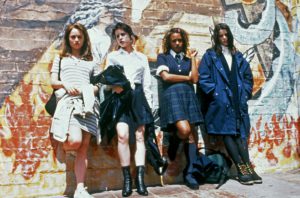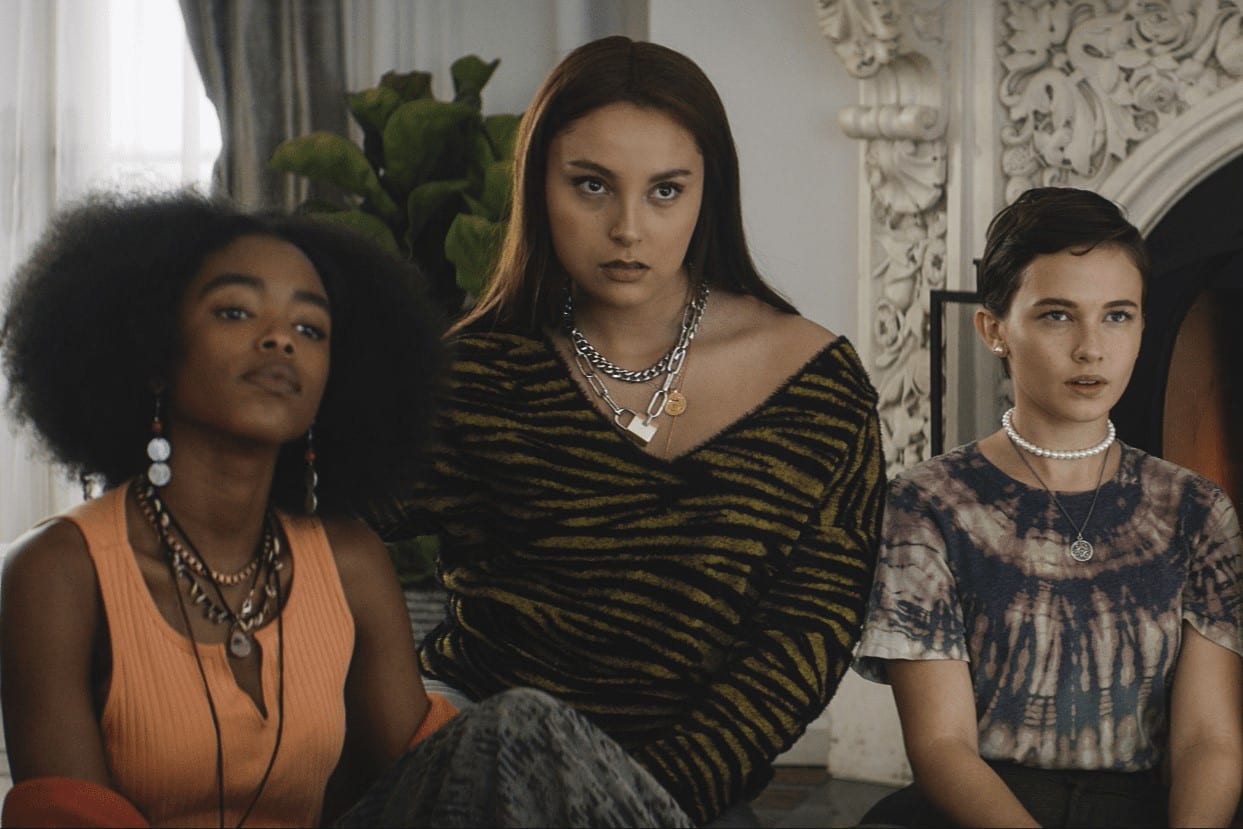The pissed-off sisterhood, the heavy black makeup, the slow-motion scenes of teen witches walking in tight T-shirts. Back in 1996, Andrew Fleming’s movie The Craft stole my pre-teen imagination and offered up a moody soundtrack of grungy alt-rock that made me feel cooler than my years. The movie worked its way into my birthday parties, where friends and I would try to make each other levitate while chanting, “light as a feather, stiff as a board.” It worked its way into my wardrobe: The delicious villain Nancy (a dream-haunting Fairuza Balk) exuded goth badassery that continues to inspire my style choices. So when I heard there was a reboot in the works, I was skeptical—any new Craft has some pretty big black leather boots to fill.
However, when I found out the film would be directed by Zoe Lister-Jones, I was thrilled that a woman would be taking the reins of the female-centric story. Mostly known for her TV roles on shows like New Girl, Lister-Jones, a self-described weirdo who sported a shaved head and spray-painted silver Dr. Martens to her conservative high school, loved the original coven, too. I was doubly happy to learn that one of the young witches would be trans, and that they had actually cast a trans woman to play her: Latina actress Zoey Luna, who plays Lourdes. Though the original film is a queer favourite, it was exciting to know that this time around, they were explicitly queering the coven.
The Craft: Legacy kicks off by introducing us to Lily (Cailee Spaeny) who, unlike her 1996 counterpart Sarah (Robin Tunney), has an alive-and-well mother and no troubled past to speak of. Instead, she’s moving in with her mom’s new flame, a welcoming David Duchovny—a masculinity expert/motivational speaker and father to (count ’em) three sons who aren’t too keen on having a girl in the house. In other words, Lily lands smack in the middle of a testosterone-drenched personal hell, though lacking some of the original melodrama. On Lily’s first day of school, one of her step-brother’s jock pals, Timmy, mocks her in front of their entire class for bleeding through her jeans. She rushes to the bathroom to cry in a stall and is consoled by her future friends and fellow witches, a real two-for-one moment that raises the issue of period shame and the importance of menstrual blood in witchcraft in one fell swoop. It’s also the moment that attracts the attention of three witches looking for a fourth to complete their coven—forging a bond of sisterhood by offering her a clean pair of shorts rather than intimidation. This is a wildly different tone than the first time around.

Robin Tunney, Fairuza Balk, Rachel True and Neve Campbell of the original “The Craft.” Credit: Peter Iovino/Columbia; Alamy
Look, I know the original Craft is far from perfect: The witches often used magic for superficial ends, like enhancing their looks, getting a boy to like them or harming another girl’s appearance as the ultimate revenge (though it was pretty satisfying to see Christine Taylor lose that beach-girl blonde hair). Mental health institutions also get a sorry, cartoonish depiction, and the good-versus-evil binary is a little too tidy. But here’s what The Craft does do: It takes a gritty look at sexual double standards, racism and sexual assault in scenes where shame and terror leap off the screen to viewers who might have experienced similar situations. The 1996 witches used magic to try and escape their very real personal issues that left them with both physical and emotional scars, rather than sprinkling it around like fairy dust to solve the world’s problems.
“The 1996 witches used magic to try and escape their very real personal issues that left them with both physical and emotional scars, rather than sprinkling it around like fairy dust to solve the world’s problems.”
Now, there’s little grit left amid the girl-power positivity that brings the witches together in the first place. Most of The Craft’s hard edges and darkness have been smoothed out and brightened up, nearly eliminating coming-of-age female rage in the process. The vampy, hitched-up Catholic-school uniform has been replaced by eclectic animal prints, bold colours, athleisure and, gasp, pearls. (With goth aesthetic now mostly the purview of glittery, Instagram-filtered e-girls and e-boys, maybe these are the witches producers thought Gen Z would want.) I promise that my sartorial objections aren’t purely nostalgia-fuelled: We’re told off-hand that these witches don’t fit in, but the foursome actually look just like every other teen in school. (They wear all-black outfits just once! And it’s at a funeral! And their parents are doing it too!) Nancy’s iconic line, “We are the weirdos, mister,” makes an appearance here, but instead of being delivered by Balk with a grin big and sharp as a wolf’s, it sounds sweet as pie in Lily’s mouth. That’s because these girls are not the weirdos. In fact, there aren’t really any weirdos in this universe at all. There are just boys like Timmy who taunt girls about their bodies, but ultimately succumb to a young coven using its powers for wokeness. In the original, the character is a lovesick puppy whose obsession with Sarah turns dangerous. In the reboot, he’s transformed into an almost comically feminist ally who (spoiler alert) comes out as bisexual.
“The vampy, hitched-up Catholic-school uniform has been replaced by eclectic animal prints, bold colours, athleisure and, gasp, pearls.”
By spending so much screen time pinning worldly woes on stifling heteronormativity and toxic masculinity (which, don’t get me wrong, is a necessary fight), the movie loses any tension that comes from developing relationships between the female characters—you know, the actual witches themselves. Unlike in The Craft, nobody here is power-hungry because they’re poor, disfigured or bullied, leading them to seek out magical ways to right their wrongs. Personal stakes are a big part of what builds tension between the original teen witches. But here, we know next to nothing about the three supporting characters or why they’re so keen to cast spells in the first place. Lily strays from the righteous path only briefly, and also not really—turns out that’s a big bad man’s fault, too. In fact, while the original installment breezes through the Bechdel test, the reboot struggles harder to pass, since the conflict no longer comes from within the coven itself.
In Legacy, we don’t get teens acting stupidly drunk on their newfound power, which is one of the most realistic plotlines in the 1996 version. There’s no deep bonding built between the girls and, most importantly, they don’t end up having much agency. That’s because the movie is less about them than the male forces oppressing them. In the original, the explosive beach scene when the coven calls upon the higher power of Manon spoke to the electric anger of countless teens. The Craft turned the emotional into something tangible: Lightning strikes, an abusive stepfather dies of a heart attack, sharks lie dead on a beach and thousands of slithering snakes invade Sarah’s home (a scene for which they used about 2,000 real reptiles). That’s what’s missing most here—young female rage that is so powerful it comes to life. There’s no intense, consuming friendship that turns lethal. There’s no teenage selfishness or personal revenge. There are no witches breaking the rules—or even the dress code. In short, there’s no magic.
Coming in the middle of lockdown, as our pandemic fatigue and anger mount, The Craft: Legacy is a gigantic missed opportunity. Many of us could have used a dark coven giving voice to our feelings of isolation, flat-out rage and perhaps even a desire to hex President Donald Trump. The #MeToo-sparked feminism and ever-growing distrust in governments has led to a huge rise in interest in witchcraft in the last years, so this reboot couldn’t have come at a better time. But although Legacy works incredibly hard to be inclusive, we spend so little time on each of the supporting witches that they end up feeling tokenized. The only thing we know about them is that they’re Black, trans or really into leopard print. Yes, heteronormativity and the patriarchy are forces we need to fight, but that message isn’t best served by being relentlessly, unrealistically positive and swapping dark lipstick for glitter. To connect with those raw, stormy feelings, it seems we’ll just have to keep going back to The Craft to have our knee-high black socks knocked off.


 Why you can trust Xtra
Why you can trust Xtra


